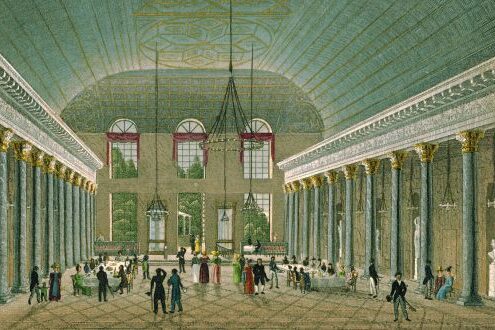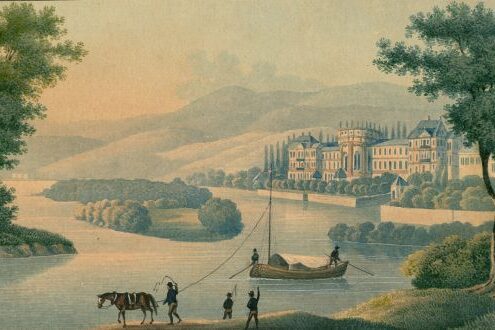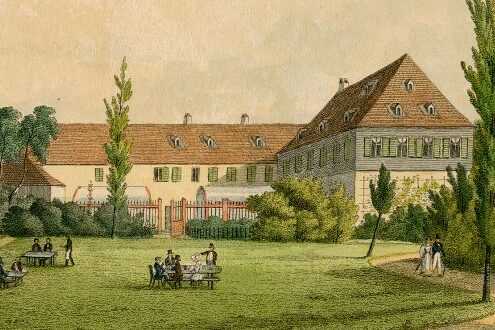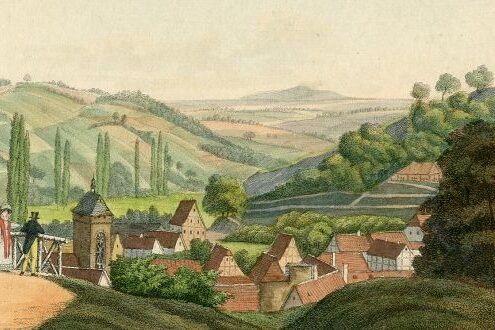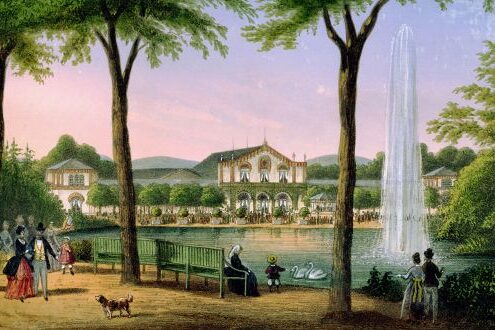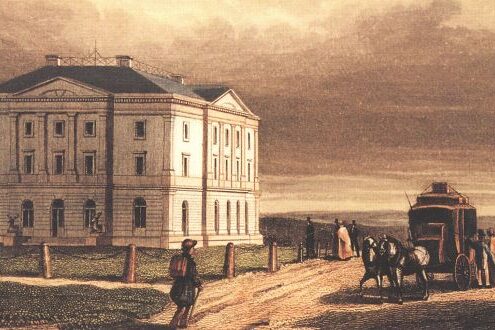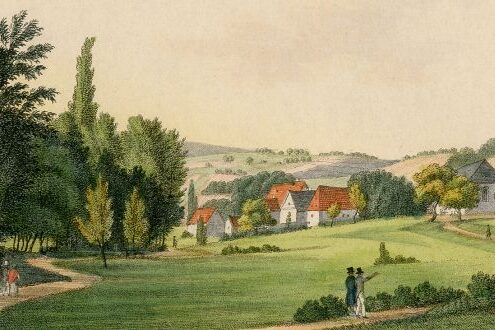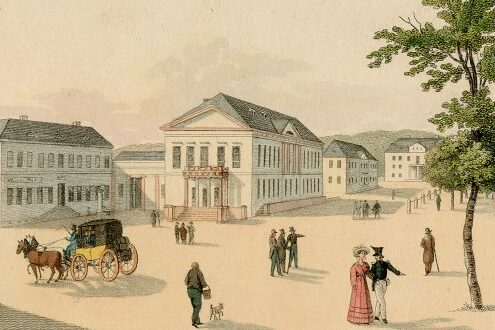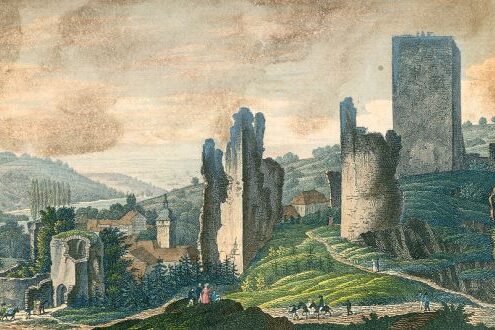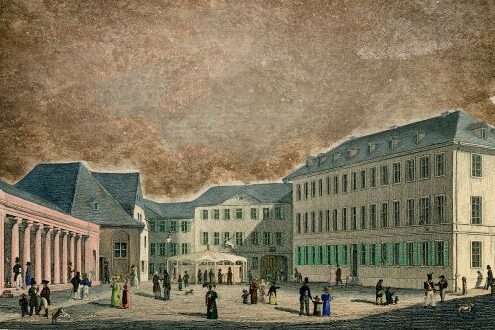Goethe in Wiesbaden
The poet Johann Wolfgang von Goethe spent several weeks in Wiesbaden as a spa guest in 1814 and 1815. He enjoyed the "Schwalbach water", the spas and explored the city. Goethe also met with well-known personalities and went on excursions to the surrounding area and the Rheingau. He was a guest at the ducal palace of Biebrich on several occasions. During this time, in which he had an intense love affair with the married Marianne von Willemer, he wrote numerous new texts, including many poems from the "West-Eastern Divan".
Goethe, Johann Wolfgang von
Born: August 28, 1749 in Frankfurt am Main
Died: March 22, 1832 in Weimar
The times of the Napoleonic Wars had not been favorable for travel. After losing the Russian campaign in 1812, Napoleon had gathered troops again, but they were crushed in the Battle of Leipzig in 1813. In the spring of 1814, the armies of the allies marched on Paris and took the city. The emperor was forced to abdicate and was banished to the island of Elba. People could think about traveling again.
Arrival
Instead of the Bohemian spas, Goethe was drawn to the Rhine regions in 1814, which he had not seen again for a long time. On July 25, he set off from Weimar for Wiesbaden, which he reached on July 29. Here, Goethe's friend, the composer Carl Friedrich Zelter (1758 - 1832), had arranged accommodation for Goethe. He initially stayed provisionally at the Hotel Adler, before moving a little later to the Hotel Bären, where Zelter was also staying. "The movement of a happy journey .... the refreshing Schwalbach water and the .... warm baths are already having such a good effect on my whole being that I expect the best," he writes to his wife Christiane (1765 - 1816) at the beginning of August. And he describes the location of the town, the "most beautiful view" from the slopes of the Taunus and the sight of the Rhine. "I want to take a good look at it all." The journey was also to be a departure into a new phase of poetic creativity: the political events had taken their toll on Goethe, as well as health and age-related complaints; his writing had also stalled. In May - shortly before setting off on his journey - he had received the "Divan" (Persian for "assembly") by the Persian poet Hafiz (14th century) from his publisher Johann Friedrich Cotta (1764 - 1832) in the new translation by Joseph von Hammer (1774 - 1856). Goethe had familiarized himself with the cultures of the Middle East at an early age (partly through the mediation of Johann Gottfried Herder, 1744 - 1803). In a distant time he now found general human forms of life, in Hafiz an author in whom he could experience himself anew. Already on the journey, he wrote his own poems as a productive response to these early texts. And Goethe hoped to escape from the present, still endangered world into an ideal one, "to link the West and the East ... in a cheerful way". At the beginning of his "West-Eastern Divan" (in the later arrangement) is the poem entitled "Hegire" ("Flight") (in analogy to the Arabic "Hedschra", the emigration of Mohammed from Mecca to Medina), whose opening lines ("North and West and South shatter/Thrones burst, empires tremble/Flee thou, in the pure East/Patriarchal air to taste") allude to current political events. The "Divan" will accompany Goethe's poetic imagination throughout his stay in Wiesbaden - and beyond.
First steps. Encounters
Now that he has settled in the spa town, he takes a look around Wiesbaden. First of all, there are the repetitive items on the agenda: The baths ("the bathing list [already] amounts to over 3,000" - with a total population of 3,500!), the drinking cure with the "Schwalbach water" (delivered fresh daily) and the walks (often together with Zelter). He often took his meals at the table ď hôte in the Kursaal (the spa host in the "Bären" was not allowed to serve his guests himself); over a hundred guests would gather there ("...to see this ... with rows of tables, where delicious food and drink is served, that is something one could lust after"). On Sundays, he is often invited to dine at Biebrich Palace, the residence of Duke Friedrich August von Nassau-Usingen.
From the very beginning, he undertook tours within the city limits as well as excursions into the surrounding area. For example, he explored the paths from Sonnenberger Tor to the Kurhaus, the Warme Damm and the "Allee" (today's Wilhelmstraße), the remains of the old city wall and the Geisberg. He will extend his walks and journeys. And he pursues his artistic and literary interests. His attention is focused on the Kurhaus built by Christian Zais, whose classicist architecture comes close to Goethe's artistic ideal based on Greco-Roman antiquity. The builder had visited Weimar in 1809 at the instigation of Weimar-based Oberhofmeister and architect Wilhelm von Wolzogen for study purposes and had the Kurhaus magnificently decorated in the style of Weimar. The columns of the Kursaal were modeled on those of antiquity ("the whole thing is imposing"). Goethe's 65th birthday was also celebrated in the Kurhaus (and in Biebrich Palace) on August 28, 1814. He also visited the theater - not least for professional reasons in his capacity as director of the Weimar court theater - which was housed in the Schützenhof at the time; it was performed by foreign theater troupes (the court theater had been closed in 1813 due to the threat of war). He also spent a lot of time in the library, whose collections caught his interest.
He soon meets representatives of the nobility, politics, art and science. Firstly, there is the Duke and his family. He also met the ducal minister Ernst Marschall von Bieberstein and the director of the ministerial chancellery, Carl von Ibell, as well as the director of the Wiesbaden public library, Bernhard Hundeshagen, whose collecting activities and historical knowledge he valued. He was also in contact with the Frankfurt diplomat and writer Johann Isaak von Gerning, whose art collection was to become the cornerstone of the Wiesbaden Museum's collection of Nassau antiquities at Goethe's suggestion. He also repeatedly attended Johannes de Laspée's elementary school, which was based on the educational methods of Johann Heinrich Pestalozzi (1746 - 1827). Goethe cultivated a particularly intensive exchange with the Oberbergrat and mineralogist Ludwig Wilhelm Cramer (1755 - 1832), whose mineral cabinet offered rich visual and study material. The same applies to Christian Friedrich Habel's natural history collection, which his son, Friedrich Gustav Habel, presented to Goethe. Accompanied by Cramer, he visits various quarries inside and outside the city. Goethe's interest in rocks was more than an expression of purely scientific interest and was not primarily the result of his Weimar experiences as chairman of the local mining commission. Rather, he believed that in nature, especially in rocks, he found the solidity and permanence that he sought in the movement and instability of inner experience. Mineralogy accompanied his weeks in Wiesbaden, including the excursions from Wiesbaden, on which he collected stones, took rock samples himself, received them as gifts and had them sent to Weimar.
Together with Zelter and Cramer, he travels to the Rheingau from August 15 to 17. Via Walluf, Eltville, Oestrich, Winkel, Geisenheim and Rüdesheim, he arrives in Bingen, where he witnesses the festival in honor of St. Roch. The Rochus Chapel had been destroyed during the previous wars and was now rebuilt - also as a symbol of the reconquered left bank of the Rhine. The pilgrimage (on August 16), which was banned during the French occupation, thus had a political as well as a religious significance. Goethe is captivated by the serene Rhine landscape and the life of the people there, but also mentions the still clearly visible consequences of the destruction. Considerations about restoring art treasures damaged in the wars were to prompt Goethe to take a corresponding initiative the following year. On the very day of his return to Wiesbaden, he began preliminary studies for his travelogue on the "St. Roch's Festival in Bingen".
Divan, a journey
He also continued his ongoing activities. He maintained an extensive correspondence, kept a diary, informed himself about new literary and scientific publications as well as the current political situation and produced extracts from works in a wide range of specialist fields. And he devotes himself to his literary works, including the description of his "Italian Journey", which he experiences as a kind of self-encounter and self-reflection.
Poems on the "West-Eastern Divan" are written in rapid succession. In the poet Hafiz, he discovered a kindred spirit, a "twin", and embarked with him on a "journey" (as he called the cycle) between the Orient and the Occident, the present and the past, a spiritual journey. "The highest character of oriental poetry", writes Goethe, "is what we ... Spirit". And he travels from the "Book of the Singer", with which he sets off for the East ("the depths of origin"), to the "Book of Paradise". The journey is a reflection of an Eastern world in a Western world and vice versa ("Only he who loves and honors Hafiz / Knows what Calderón sang", it says in the "Book of Proverbs"). Themes and motifs are taken from oriental poems; references to formal elements are rather rare.
The themes are manifold: poetry, love, wine, nature, criticism of the times, right up to the "higher" and "highest", which actually eludes linguistic form and comprehensibility. The sensual always corresponds to a spiritual moment - thus love is always also spiritual love, drunkenness always also spiritual intoxication, the finite a mirror of the infinite. The poetic device is the symbol. "The true, identical with the divine, can never be recognized by us directly, we see it only in reflection, in example, symbol...", writes Goethe in his "Witterungslehre". "All that is transient is but a parable", it will say in the "Chorus mysticus" at the end of "Faust, Part Two".
Shortly after his arrival in Wiesbaden, Goethe wrote his poem "Selige Sehnsucht" (Blissful Longing) with the image - borrowed from Hafiz - of the "butterfly", which dies a "flaming death" when flying into the "silent candle", escaping an existence as a "dull guest" on the "dark earth" in Goethe's text and gaining a higher form of existence ("And as long as you have not,/This: Die and become!/You are only a dull guest/On the dark earth"). This process of "die and become" occurs frequently in Goethe's work; he also mentions this process in letters and conversations during his stay in Wiesbaden; he also calls it "rejuvenation" and "rebirth". It will also give the "Divan" new impetus.
On August 4, 1814, Goethe received a visit in Wiesbaden from Johann Jacob von Willemer (1760 - 1838), a banker and patron of the arts from Frankfurt whom he had known for many years, and his foster daughter Maria Anna (Marianne) Jung (1784 - 1860, originally a member of an acting and ballet troupe), whom he married the following month. Goethe paid return visits in September and October. A passionate love affair was to develop between him and Marianne, but the public never found out about it.
Farewell and return
After his departure from Wiesbaden on September 12, Goethe spends a few days in Winkel at the Brentano family home and takes excursions from there to the Rheingau; after visiting the Willemers, he travels to Heidelberg to visit the brothers Sulpiz (1783 - 1854) and Melchior Boisserée (1786 - 1851), who have amassed an important art collection of old Dutch and old German paintings there. The encounter with this art would also have a lasting effect on Goethe's second trip to Wiesbaden. In the meantime, further texts were added to the "Divan". Goethe undertakes intensive studies of the culture and history of the Orient and also makes contact with representatives of academic Oriental studies. These activities made him feel "removed" from the times. In September 1814, the Congress of Vienna began negotiations on the territorial reorganization of Europe. In March 1815, Napoleon left the island of Elba and entered Paris. Once again, the Allies gather troops and the war begins anew. But even if it is "most unpleasant to live "out on the Rhine" in view of the current political situation" - Goethe writes to Zelter in April - "Wiesbaden has done me far too much good and I would like to repeat it".
On May 27, 1815, after a journey "through marching columns", he once again arrives in Wiesbaden. Once again he stayed at the "Bären", once again he conscientiously completed his spa program, and once again he met up with conversation partners from the previous year. He also went on excursions again, to the Klostermühle near Klarenthal, the Platte and the Geisberg. He is soon able to report: "Now I'm pretty much settled, I live very nicely ... eat well ... bathe in the salubrious Wiesbade[n], all this suits me quite well and I can be active". He continues to work on the "Italian Journey" ("I dictate" - he writes - "even in the bath"), new "sections" of the "West-Eastern Divan" are created, for which he compiles an index (the so-called "Wiesbaden Index") due to the abundance of newly created texts. And - after the "good spirits of the Orient" had already visited him again on the journey here - he was virtually immersed in their sphere. "The roses are in full bloom, the nightingales are singing ... and so it is no art to transport oneself to Shiraz" - alluding to the nightingale's love of the rose, a motif of oriental poetry.
As in 1814, Goethe is also to be found in the theater. This time he is particularly interested in the stage sets; as in the previous year, he remains silent about the plays performed and their authors. "After the end of the play, when the illumination is still complete, he has several sets shown to him", where he sees "on a large scale" "what we already know on a small scale and what is to be executed on a larger scale here [i.e. in Weimar]". The theater painter Friedrich Christian Beuther (1777 - 1856) became a stage designer in Weimar in 1815. Goethe also considers possible engagements in Weimar; in this context he mentions - as in 1814 - Philippine Lade (1797 - 1879), the sister of the court apothecary Johann August Lade, who also visits the theater with Goethe and accompanies him on several excursions. He was also interested in building activity and urban planning in Wiesbaden. "A lot is being built here ... There are streets that would do credit to the largest city ... The inhabitants are stimulated [i.e. encouraged] to build by the most favorable circumstances. They receive the squares from the rulers, a considerable building allowance [i.e. a building subsidy], but they have to build in accordance with the regulations." And Goethe refers to the local quarries, which partly provide the material. He lives "as if in the deepest peace ... If I did not see Easterners and Prussians in Biebrich on Sundays, I would not even know that war was imminent....", he writes on June 17, and finally receives news of the Allied victory over Napoleon at Waterloo on June 21 (June 18). "The great news of the loss [of the allies] first, then of the victory, hit hard here". Wiesbaden now even appeared to him as a place where "all the radii of the present world movements converge". France's representative at the Congress of Vienna, Charles Maurice de Talleyrand (1754 - 1838), also stayed in the city.
Between July 21 and 31, Goethe undertakes a journey down the Rhine to Cologne in the company of Baron Karl vom und zum Stein (1757 - 1831). There, in addition to the cathedral, he visits various private collections with works of medieval art, including that of Ferdinand Franz Walraf (1748 - 1824). This aroused his interest in the art of the Middle Ages - with generally very changeable relationships - and there were points of contact with the Romantics, even if his taste in art remained committed to antiquity. Stein encourages Goethe to write a memorandum to the Prussian government in order to suggest to the new rulers on the Middle Rhine - also in view of the destruction caused by the war - measures for the restoration, preservation and promotion of art treasures and corresponding institutions following the reorganization of the European state system agreed at the Congress of Vienna. In Wiesbaden, Goethe begins preparatory work on these cultural policy plans. He will write about the monuments and art treasures he visits in "Kunst und Altertum am Rhein und Main" (1816). In line with the memorandum, he also wrote to Prince Clemens Wenzel von Metternich (1773 - 1859) from Wiesbaden.
Lyrical dialog. Epilogue
On August 22, he leaves Wiesbaden accompanied by Sulpiz Boisserée. Goethe then visits the von Willemer family several times in August and September. The love affair between Goethe and Marianne von Willemer finds expression in the poems of the "West-Eastern Divan", not as a reflection of reality, but - mirrored in a West-Eastern world - as its aestheticization. Oriental names are found for the lovers, "Hatem" and "Suleika". And Eastern motifs appear, such as "Bulbul", the nightingale, and "Hudhud", the messenger of love, the cypress tree as a symbol for the beloved and the "Gingo biloba" - in the autograph of September 15, 1815 "Gingko biloba" - the gingko tree that has also become native to Europe, coming from the East, whose leaf has an incision in the middle, as if it were two leaves that have grown together. This phenomenon fits in with Goethe's idea of polarity as a principle of life and of the relationship between two poles - in this case lovers: love as nature, as a personal experience ("that I am one and double") and as a cosmic event. The gingko leaf can also be read as an allusion to the idea expressed by Plato in the "Symposium" of the halves originally belonging together and seeking each other. In his writings on natural history, Goethe also sought to understand natural processes as polar processes, for example in his Theory of Colors, in which he describes colors as arising from the clash of light and dark.
The "double" gingko leaf finds an equivalent in the lyrical dialog that develops between Goethe and Marianne. Marianne becomes a poet, she "responds" - in the "Book of Suleika" - to Goethe's verses, she also adopts a motif from Hafiz, the "east wind" that blows towards her beloved, and she speaks "west-east" by placing the "west wind" at his side ("What does the movement mean/Bring the east glad tidings to me?" and "Ah, for your moist wings,/West, how I envy you"). Goethe includes her texts in the "Divan" without - for reasons of discretion - identifying them as his own. After another brief meeting in Heidelberg, the two would remain in contact, write letters to each other and send poems - including "cipher poems" with coded messages referring to individual stanzas and lines in Hafiz; they would not see each other again.
In July 1816, Goethe set off again for Wiesbaden in his carriage, the "Fahrhäuschen", but an accident occurred before Erfurt. Goethe - although uninjured - sees this as an unfavorable omen and breaks off the journey. He now returned to the Bohemian spas, as he had done before 1814. During his weeks in Wiesbaden, however, he had experienced a "heightening", understood as the highest form of creative expression of life, and a kind of "transformation". And it is probably no coincidence that in one of his last conversations with Sulpiz Boisserée in Wiesbaden, he mentions a phenomenon that he sees as fundamental to all developmental processes in nature "from plants and animals to man": metamorphosis.
Goethe's stays in Wiesbaden are commemorated by the Goethe Monument, the Goethe-Warte and the Goethe Stone. The Goethe Society (Literary Societies) is dedicated to Goethe's work and influence.
Literature
Works:
- Goethe, Johann Wolfgang von
Works. Hamburg edition in fourteen volumes, edited by Erich Trunz, 12th edition, Munich 1981.
- Goethe, Johann Wolfgang von
Goethe's life from day to day. A documentary chronicle by Robert Steiger and Angelika Reimann, Volume VI, 1814 -1820, Zurich and Munich 1993.
- Goethe, Johann Wolfgang von
Complete works. Letters, diaries and conversations. 2.. Section. Volume 7, edited by Rose Unterberger, Frankfurt am Main 1994.
Literature:
- Faber, Rolf
Goethe as a spa guest in Wiesbaden. In: Wiesbadener Leben, issue 3, Wiesbaden 1982.
- Faber, Rolf
"That I am one and double". Goethe - Hatem and Marianne - Suleika. In: Wiesbadener Leben, Issue 3, Wiesbaden 1983.
- Hildebrand, Alexander
Serious magic play. Goethe's experience of himself and the world in Wiesbaden. In: Wiesbadener Leben, issues 10, 11, 12, Wiesbaden 1989.
- Czysz, Walter
Goethe in Wiesbaden. In: From Roman bath to world spa town, Wiesbaden 2000.
- Safranski, Rüdiger
Goethe. Work of art of life. Munich 2013.
